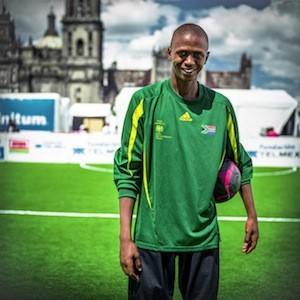
Photographer Anthony Epes attended the 2012 Homeless World Cup in Mexico City and the 2013 tournament in Poznań, Poland, taking portraits of the participants with his Hasselblad camera. An exhibition of the photographs opened in London this month at Downstairs at Mother, and on June 16 it will reopen at Spitalfields Market as part of the East End Film Festival.
For his Homeless World Cup project, Epes says he “wanted to create beautiful portraits that would reveal some of the powerful changes within the players as they progress through the tournament.” An entry on the Homeless World Cup blogreemphasizes that the California-born, London-based Epes “believes that if he can make something beautiful then people will want to look at it and start a discussion.” The vibrant portraits capture what was most striking to him about the event: how it transformed the players through the sport.
Rather than show them in action, Epes captures the players in moments of stillness, on the field or in the host city, reflecting something of each person, their past, and their passion for soccer. For example, there’s Shankari Krishnan, who was part of Team India in 2013, luminous against an overgrown railroad track. Krishnan “started playing football by chance but she soon found that not only was she very good at the sport, but it also provided her an outlet and a diversion.” She’s now pursuing an undergraduate degree program that she was admitted to under a sports quota.
There’s also Donnie Nicholson, of the 2012 Team USA, posed against the soft light of a pop-up amusement park. Nicholson practiced at pick-up games in NYC’s Chinatown and on the Rockaway Boardwalk, playing “to kick cocaine” and “reconnect with Family [sic] and now have a Family on the pitch in many countries.”
The Homeless World Cup has 72 teams every year of men and women (who play separately), from Haitian refugees to residents of India’s slums. The organization also works to establish grassroots soccer programs in participating countries, as well as advocate for initiatives to help end homelessness. Taking place alongside the much costlier World Cup, it also coincides this year with protests in Brazil by organizations like the Homeless Workers Movement over the World Cup’s overspending on the tournament instead of on local needs. Just last week thousands of homeless people marched on the Sao Paulo World Cup stadium, and in early May a number of poor families occupied land near the stadium (which did result in the city designating it for low-income housing). Epes’s portraits add to the greater dialogue of what sports can mean, how a game like soccer can be an essential outlet, and how each country represented in the pomp of the World Cup also has its own chasing shadow of poverty.